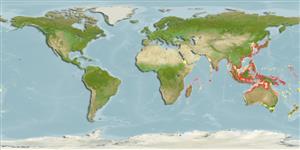Common names from other countries
Environment: milieu / climate zone / depth range / distribution range
Ökologie
seewasser; brackwasser riff-verbunden; tiefenbereich 5 - 40 m (Ref. 90102). Tropical
Western Pacific: Gulf of Thailand to southern Japan, Philippines (Ref. 9494), Borneo and Indonesia. Absent from New Guinea and Australia.
Size / Gewicht / Alter
Maturity: Lm ? range ? - ? cm
Max length : 26.0 cm TL Männchen/unbestimmt; (Ref. 90102); common length : 16.0 cm TL Männchen/unbestimmt; (Ref. 9893); max. veröff. Gewicht: 168.50 g (Ref. 124479)
Rückenflossenweichstrahlen (insgesamt) : 74 - 78; Afterflossenweichstrahlen: 65 - 68; Wirbelzahl: 51 - 52.
Inhabits shallow sand and mud bottoms of coastal waters. Feeds mainly on benthic invertebrates, especially small crustaceans. Marketed fresh, frozen, and dried-salted.
Life cycle and mating behavior
Maturities | Fortpflanzung | Spawnings | Egg(s) | Fecundities | Larven
Munroe, T.A., 2001. Soleidae. Soles. p. 3878-3889. In K.E. Carpenter and V. Niem (eds.) FAO species identification guide for fishery purposes. The living marine resources of the Western Central Pacific. Vol. 6. Bony fishes part 4 (Labridae to Latimeriidae), estuarine crocodiles. FAO, Rome. (Ref. 9893)
IUCN Rote Liste Status (Ref. 130435)
CITES (Ref. 128078)
Not Evaluated
Bedrohung für Menschen
Harmless
Nutzung durch Menschen
Fischereien: kommerziell
Tools
Zusatzinformationen
Download XML
Internet Quellen
Estimates based on models
Preferred temperature (Ref.
115969): 21.3 - 29.1, mean 28.3 (based on 882 cells).
Phylogenetic diversity index (Ref.
82804): PD
50 = 0.5000 [Uniqueness, from 0.5 = low to 2.0 = high].
Bayesian length-weight: a=0.00794 (0.00492 - 0.01282), b=3.10 (2.96 - 3.24), in cm Total Length, based on LWR estimates for this species & (Sub)family-body (Ref.
93245).
Trophic level (Ref.
69278): 3.5 ±0.50 se; based on food items.
Widerstandsfähigkeit (Ref.
120179): mittel, Verdopplung der Population dauert 1,4 - 4,4 Jahre. (Preliminary K or Fecundity.).
Fishing Vulnerability (Ref.
59153): Low vulnerability (16 of 100).
